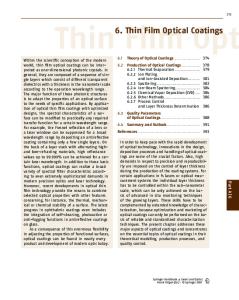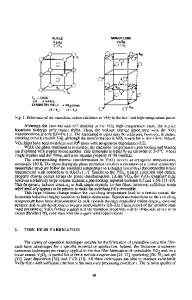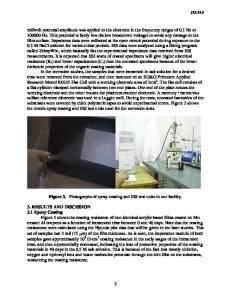Applications of Active Thin Film Coatings on Optical Fibers
- PDF / 3,672,771 Bytes
- 10 Pages / 414.72 x 648 pts Page_size
- 29 Downloads / 374 Views
fiber coatings, a sample holder was designed that allowed for rotation of the fiber substrates while they were held vertically in front of the
magnetron sources. The lengths of the deposited onto the fibers
Quartz L~amp Heater
-coatings
j were determined by shadow masks.
Mas
ZnO coatings were by using either a single magnetron source or two magnetron oC Magnetron iSource sources that were positioned (ZnTarget) target normals at 900. A singlewith their magnetron was used for the io deposition of ZnO coatings up to 6 gin thick while a dual magnetron configuration was used to produce coatings up to 20 pin thick. Zn metal targets were sputtered in a reactive mixed atmosphere of oxygen and sputtering magnetron dual of Schematic 1. FIG. argon while maintaining an oxidized system used for deposition of ZnO optical fiber target surface layer. The total chamber coatings. pressure, power, and oxygen partial pressure were carefully maintained near the transition between an oxidized target surface and a metal target surface since these conditions resulted in a high deposition rate and ZnO films with preferred orientation and a piezoelectric wurtzite type structure. Since ZnO exhibits a fixed polarization that cannot be reoriented after growth, ZnO thin films with a preferred orientation are required in order to excite a macroscopic piezoelectric response. The ZnO fiber coatings consist of Rotating Fiber Holder Microbalance
0Piezoelectric 0deposited
columnar grains that exhibit an [0001] preferred orientation along the column axis. A radial [0001] preferred orientation of the fiber coating results since the columnar ZnO grains grow along the radial direction with respect to the fiber axis. Debye-Scherrer X-ray diffraction was used to determine the radial texture of the ZnO film. The ZnO film exhibits an oom symmetry with respect to the radial vector, but the complete fiber structure has an -/mm symmetry. Concentric Cr/Au electrode coatings for ZnO based devices were deposited by thermal evaporation. A rotating fiber holder and shadow masks similar to those used for the ZnO deposition were employed. Details on the deposition process of the ZnO and Cr/Au electrode structures have been previously reported [4, 5]. Concentric fiber coatings of Ti and Pt were employed as a resistive coating for thermally tunable fiber devices. The Ti layer improves the adhesion between the Pt coating and the glass fiber, while the Pt layer provides the resistive coating that is heated by passing a current. This combination of metal thin films for the resistive coating was chosen because it has been demonstrated that the coating remains stable in oxidizing atmospheres to temperatures above 500"C [6]. The Ti and Pt were sequentially deposited using the same sputtering system that was used for the ZnO fiber coatings, but the geometry of the system was slightly altered. Instead of placing the two magnetrons at a 90" angle, the two magnetrons were placed at a 450 angle. The conditions for the Ti and Pt deposition have been reported elsewhere [7].
Data Loading...









